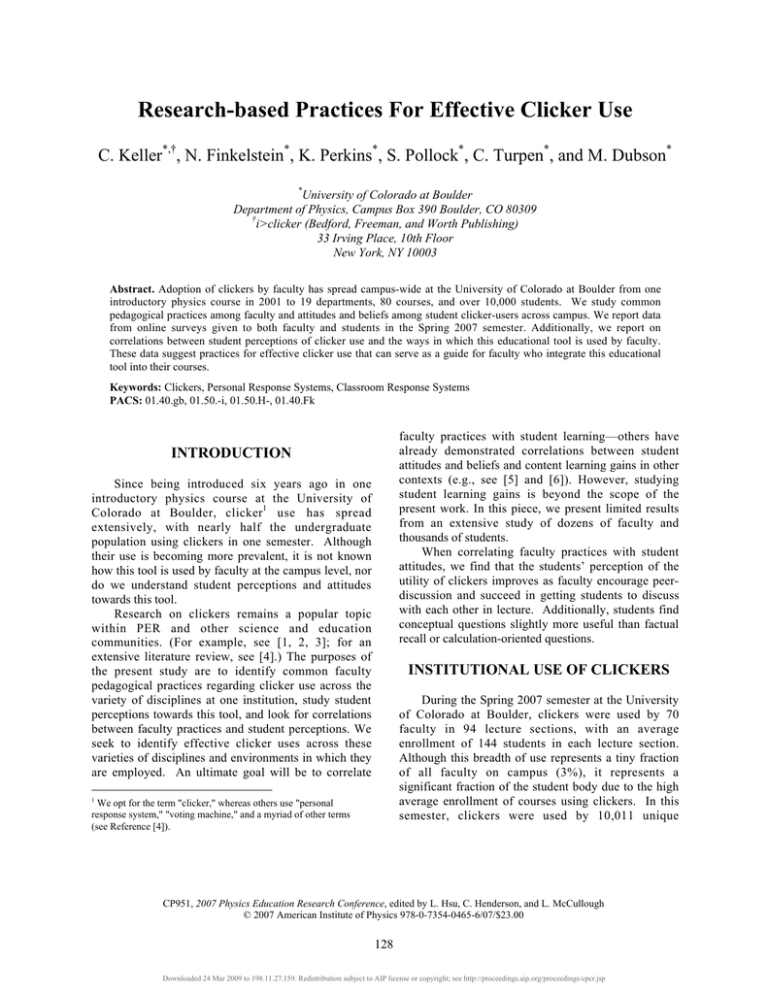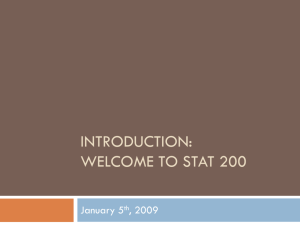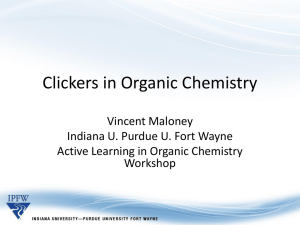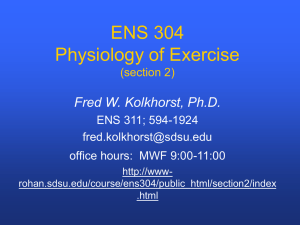Research-based Practices For Effective Clicker Use C. Keller , N. Finkelstein
advertisement

Research-based Practices For Effective Clicker Use C. Keller*,†, N. Finkelstein*, K. Perkins*, S. Pollock*, C. Turpen*, and M. Dubson* * University of Colorado at Boulder Department of Physics, Campus Box 390 Boulder, CO 80309 † i>clicker (Bedford, Freeman, and Worth Publishing) 33 Irving Place, 10th Floor New York, NY 10003 Abstract. Adoption of clickers by faculty has spread campus-wide at the University of Colorado at Boulder from one introductory physics course in 2001 to 19 departments, 80 courses, and over 10,000 students. We study common pedagogical practices among faculty and attitudes and beliefs among student clicker-users across campus. We report data from online surveys given to both faculty and students in the Spring 2007 semester. Additionally, we report on correlations between student perceptions of clicker use and the ways in which this educational tool is used by faculty. These data suggest practices for effective clicker use that can serve as a guide for faculty who integrate this educational tool into their courses. Keywords: Clickers, Personal Response Systems, Classroom Response Systems PACS: 01.40.gb, 01.50.-i, 01.50.H-, 01.40.Fk faculty practices with student learning—others have already demonstrated correlations between student attitudes and beliefs and content learning gains in other contexts (e.g., see [5] and [6]). However, studying student learning gains is beyond the scope of the present work. In this piece, we present limited results from an extensive study of dozens of faculty and thousands of students. When correlating faculty practices with student attitudes, we find that the students’ perception of the utility of clickers improves as faculty encourage peerdiscussion and succeed in getting students to discuss with each other in lecture. Additionally, students find conceptual questions slightly more useful than factual recall or calculation-oriented questions. INTRODUCTION Since being introduced six years ago in one introductory physics course at the University of Colorado at Boulder, clicker1 use has spread extensively, with nearly half the undergraduate population using clickers in one semester. Although their use is becoming more prevalent, it is not known how this tool is used by faculty at the campus level, nor do we understand student perceptions and attitudes towards this tool. Research on clickers remains a popular topic within PER and other science and education communities. (For example, see [1, 2, 3]; for an extensive literature review, see [4].) The purposes of the present study are to identify common faculty pedagogical practices regarding clicker use across the variety of disciplines at one institution, study student perceptions towards this tool, and look for correlations between faculty practices and student perceptions. We seek to identify effective clicker uses across these varieties of disciplines and environments in which they are employed. An ultimate goal will be to correlate INSTITUTIONAL USE OF CLICKERS During the Spring 2007 semester at the University of Colorado at Boulder, clickers were used by 70 faculty in 94 lecture sections, with an average enrollment of 144 students in each lecture section. Although this breadth of use represents a tiny fraction of all faculty on campus (3%), it represents a significant fraction of the student body due to the high average enrollment of courses using clickers. In this semester, clickers were used by 10,011 unique 1 We opt for the term "clicker," whereas others use "personal response system," "voting machine," and a myriad of other terms (see Reference [4]). CREDIT LINE (BELOW) TO BE INSERTED ON THE FIRST PAGE OF EACH PAPER CP951, 2007 Physics Education Research Conference, edited by L. Hsu, C. Henderson, and L. McCullough © 2007 American Institute of Physics 978-0-7354-0465-6/07/$23.00 128 Downloaded 24 Mar 2009 to 198.11.27.159. Redistribution subject to AIP license or copyright; see http://proceedings.aip.org/proceedings/cpcr.jsp students, which include 9,941 undergraduates and 70 graduate students. Students using clickers made up 44% of all undergraduate students and 1.6% of graduate students. Despite the widespread use among the undergraduate student body, there is still opportunity for clicker use to expand. Only 28% of departments on campus are using clickers and only 24% of large lecture sections (where the enrollment is greater than 100) are using clickers. We see some departments that currently use clickers in all large lecture courses that they offer, such as Physics, Astrophysics, and Chemical Engineering. Other large departments, such as Psychology and Sociology, use clickers in 1 and 2 large courses (out of 16 and 7, respectively). We find the majority of courses using clickers to be in STEM fields. The total number of courses that used clickers in STEM fields was 63, while there was 10 in Business, 6 in Social Sciences, and 1 in Humanities. Of the 94 lecture sections2 using clickers, 79 of these are using i>clicker3 and the remaining 15 are using H-ITT4. Of all unique students who used clickers, 70% used clickers in one course only, while 29% used clickers in 2 courses, and fewer than 1% used clickers in either 3 or 4 courses. questions given per day and the overall percentage of class days when clickers are used throughout the semester (see Table 1 & 2). However, the majority of faculty asks 3 to 4 questions per day and use clickers 90 – 100% of class meetings over the semester. TABLE 1. Average number of questions given per class meeting, reported by faculty Number of Clicker % of Courses [standard error]† Questions N=69 1 to 2 19 [5] 3 to 4 5 to 6 65 [6] 13 [4] 7 or more 3 [2] † Bracketed numbers in tables are estimated standard error of the mean. TABLE 2. Percent of all classes days when clickers are used, reported by faculty % of class days % of Courses, N=69 < 50% 7 [3] 50 - 75% 75 - 90% 4 [3] 20 [5] 90 - 100% 68 [6] In addition to reports of frequency of use, we examine how clickers are used. Figure 1 reports the frequency of use of several broad categories of clicker questions. FACULTY PRACTICES Average Frequency, 1-5 (rarely - often) Faculty using clickers were given two different online surveys. The first survey was given at the start of term approximately 3 weeks after the beginning of classes, and 54 faculty responded to 16 multiple-choice and long answer questions. The second online survey was given at the end of term, and 69 responses were collected to 15 multiple-choice and long answer questions. To access both surveys, see [4]. Questions from both surveys probed how faculty used clickers in their own courses and on their experience and beliefs surrounding clickers. The results presented in this section were collected from both faculty surveys. Observational data of classroom practices demonstrate some similar trends as seen in faculty self-reported data presented here for a subset of physics courses using clickers. [7] The majority of faculty using clickers has little or no experience using this tool—59% of the respondents are using clickers for the first time or have only one prior semester of clicker experience. Some slight variation does exist in how frequently faculty use clickers, in terms of the average number of 5 4 3 2 1 CONCEPTUAL FACTUAL RECALL OPINIONS ATTENDANCE CALCULATIONS QUIZZES Question Type FIGURE 1. Types of clicker questions used, reported by faculty. We see some variation in the extent to which faculty encourage discussion among their students, and the extent to which students do discuss with their peers in lecture (according to faculty). The majority of faculty claim to encourage discussion and claim to succeed at getting a large fraction of students to discuss in lecture (see Table 3). 2 Note that many courses have multiple lecture sections; hence the difference between 80 courses and 94 lecture sections. 3 http://www.iclicker.com 4 http://www.h-itt.com 129 Downloaded 24 Mar 2009 to 198.11.27.159. Redistribution subject to AIP license or copyright; see http://proceedings.aip.org/proceedings/cpcr.jsp When asked what they normally do during the delivery of a clicker question, most students claim to be actively participating in discussions with their peers (see Table 4). The utility of different types of clicker questions was rated. Students found conceptual questions the most useful (3.92 ± 0.02, on a scale of 1–5, negative to positive), followed by factual recall (3.51 ± 0.02), and numerical calculations (3.32 ± 0.02). TABLE 3. Extent of peer-discussion, reported by faculty Type of Discussion Do not allow discussion Do not encourage discussion, & small fraction of students discuss Do not encourage discussion, & large fraction of students discuss Encourage discussion, & small fraction of students discuss Encourage discussion, & large fraction of students discuss % of Faculty 3 [2] 6 [3] 6 [3] 22 [5] 63 [6] CORRELATIONS BETWEEN FACULTY PRACTICES & STUDENT ATTITUDES STUDENT PERCEPTIONS & PRACTICES The final goal of the present work is to study what impact faculty practices regarding clickers have on student attitudes. We begin to determine these relations by correlating faculty use of this tool with student perception of clickers. It is commonly argued that encouraging discussion among students is of greater benefit than passively using clickers in lecture [2]. We find there to be a strong relationship between the extent of peerdiscussion in lecture and students’ attitude towards the utility of clickers. Of course, students do not uniformly agree within a single course when asked to what extent their instructor encourages discussion. Taking the mode of student responses to be an accurate representation of how instructors encourage student discussion, the average fraction of students with a favorable attitude towards the utility of clickers is 66% in courses where instructors encourage discussion and get a large fraction of students to do so (see Table 5). Approximately one month prior to the end of term, an online survey was distributed to students in courses where clickers were currently being used. To access the student survey, see [4]. Of the 10,011 students using clickers, 3,697 responses were collected. The 11 multiple-choice questions on the survey probed students’ attitudes and beliefs about clickers and asked them to respond to how clickers are currently being used in their courses. Of the 80 courses using clickers, data from students were collected in 51 courses. The data presented in this section are a summary of results from the student survey. Overall, we find students’ experience with clickers to be positive. 56.4% of students responding had a favorable attitude towards the utility of clickers in their respective courses (compared to 22.9% that were neutral and 20.7% that had unfavorable attitudes) and 55.3% of students had a favorable attitude towards the enjoyment of clickers (compared to 24.5% that were neutral and 20.2% that had unfavorable attitudes). These favorable results for clickers are noted elsewhere (for example, see [8]). TABLE 5. Average percent of students who have favorable attitudes towards clicker use, listed by classes where plurality of students reported use of clickers in stated fashion. Type of Discussion % Favorable TABLE 4. Student discussion practices during clicker questions, reported by students Student Practice % of Students, N=3,697 Usually not allowed to talk with other 2 [0.03] students Rarely use a clicker in this course 1 [0.01] Guess the answer and do not check 2 [0.03] with other students Actively think about the question 19 [0.3] independently and arrive at an answer without speaking or listening to other students Listen to other students' answers 18 [0.2] and/or reasoning Actively participate in discussions with 59 [0.4] other students around me Does not allow discussion 38 [5] Does not encourage discussion, & small fraction of students discuss Does not encourage discussion, & large fraction of students discuss Encourages discussion, & small fraction of students discuss Encourages discussion, & large fraction of students discuss 37 [8] 36 [22] 55 [8] 66 [3] Similarly, we examine how the role of students during a question correlates with their perceived utility of the clickers. We see a trend toward students finding clickers more useful as they become more active in lecture, with 64% of the students who claim to be actively participating in discussion having a favorable attitude towards the utility of clickers (see Table 6). 130 Downloaded 24 Mar 2009 to 198.11.27.159. Redistribution subject to AIP license or copyright; see http://proceedings.aip.org/proceedings/cpcr.jsp We also see a strong correlation between the instructor’s experience with clickers (i.e., the number of prior semesters where an instructors has taught with clickers) and student perception of utility (r=0.52), suggesting that faculty become better over time at effectively using this tool and that novice faculty may need more assistance. In addition to students finding conceptual questions more useful than other types of questions, the fraction of students in a course who claim to be actively participating is correlated with the average student rating of utility of conceptual clicker questions within a course (r=0.43), suggesting that conceptual questions are most useful when students discuss the questions with their peers. based evidence of their effective use. At this point, we can make two suggestions to faculty that are supported by this work: 1) encourage students to discuss with their peers during clicker questions and create environments that get students to discuss; and 2) ask conceptual questions appropriate for most students’ level of knowledge. Other research-based suggestions exist, but this is a topic for future work. For example, how do faculty practices differ between the highest and lowest rated courses, as measured by student perception of the utility of clickers? How useful to students are clickers compared to other course resources? How do varying methods of awarding credit for clicker use affect students’ attitudes? Future work will seek to answer these questions to provide guidelines on the effective use of clickers to the expanding population of novice clicker-using instructors. TABLE 6. Percent of students from each student role who have favorable attitudes toward the utility of clickers. Student Role % Favorable Does not apply--usually not allowed to talk with other students Rarely use a clicker in this course Guess the answer and do not check with other students Actively think about the question independently and arrive at an answer without speaking or listening to other students Listen to other students' answers and/or reasoning Actively participate in discussions with other students around me ACKNOWLEDGMENTS 28 [5] 16 [6] 17 [4] This work has been supported by the NSF (DUECCLI 0410744 and REC CAREER# 0448176), AAPT/AIP/APS (Colorado PhysTEC program), University of Colorado, and i>clicker (Bedford, Freeman, and Worth Publishing). The authors express their gratitude to the faculty and students who participated in this study, in addition to Shaun Piazza and the rest of the Physics Education Research Group at the University of Colorado at Boulder. 51 [2] 45 [2] 64 [1] REFERENCES CONCLUSION 1. This study presents self-reported faculty pedagogical practices and student perceptions of clicker use at a large research university across many disciplines. In addition to shedding new light on how this tool is being used by faculty and its corresponding perception by students, we wish to use these data to study how faculty practices impact student behaviors and views. Student attitude is strongly impacted by the extent to which faculty encourage and succeed in generating peer-discussion during the administration of clicker questions. Students have a much more positive attitude towards the utility of clickers if faculty encourage discussion and are able to get a large fraction of students discussing. Likewise, student attitude is also improved when students are actively participating in discussions with their peers, as opposed to being passive or working independently. We wish to move beyond providing disciplinespecific and/or anecdotal suggestions with regard to the use of clickers. Rather, we seek to provide research- 2. 3. 4. 5. 6. 7. 8. Banks, David A. (ed.) Audience response systems in higher education: applications and cases. Information Science Publishing, 2006. E. Mazur, Peer Instruction. Prentice Hall, New Jersey, 1997. Caldwell, J. CBE—Life Sciences Education, Vol. 6, Spring 2007. http://www.colorado.edu/physics/EducationIssues/ keller/clicker.html N.D. Finkelstein and S.J. Pollock, Phys. Rev. ST Phys. Educ. Res. 1, 010101 (2005). K.K. Perkins, W.K. Adams, N.D. Finkelstein, S.J. Pollock, and C.E. Wieman. “Correlating student attitudes with student learning using the Colorado Learning Attitudes about Science Survey.” PERC Proceedings, 2004. Turpen, C., Finkelstein, N., and Keller, C., “Understanding Faculty Use of Peer Instruction,” PERC Proceedings 2007 (this volume). d’Inverno, R., Davis, H., and White, S., “Using a personal response system for promoting student interaction.” Teach. Math. Appl. 22(4), 163-169. 131 Downloaded 24 Mar 2009 to 198.11.27.159. Redistribution subject to AIP license or copyright; see http://proceedings.aip.org/proceedings/cpcr.jsp




